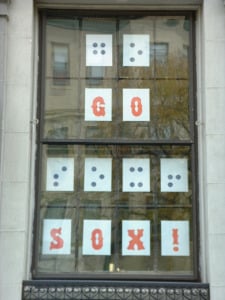As I accepted the National Disability Awareness Recognition Award, which NBP received from the Massachusetts Bay Transit Authority (MBTA), I couldn’t help but think back to thirty years earlier when the MBTA, better known as the “T,” came into my life because of braille. As a little boy, I had no interest in anything that was related to blindness, particularly the cane and braille.
However, my mobility instructor, Paul McDade, was undeterred in getting me to learn how to use the cane and travel on the T independently. One day, he presented two very interesting things.  First, he suggested that I learn how to get to Fenway Park, something every young Red Sox fan should know. How else can a Red Sox fan cheer on his favorite players?
First, he suggested that I learn how to get to Fenway Park, something every young Red Sox fan should know. How else can a Red Sox fan cheer on his favorite players?
Second, he gave me an MBTA tactile map in braille. He presented it as the tool I would need to map out my route, but it was much more than that. Playing with the map and tracing each T Line gave me an understanding of the different routes. Feeling the contours of the lines and knowing which stop was which, not only helped me figure out how to get to Fenway, but it also got me interested in riding the T. I had every stop on the MBTA memorized in no time at all from studying the braille subway map.
At 7 1/2, I was getting to Fenway Park by myself. I used my cane, got on the Red Line in Central Square, rode to Park Street, and then boarded the Green Line for Kenmore Square. The braille map promised adventure. There were other places I wanted to go, so I began to look forward to mobility class and riding the T!
It's funny how sometimes life is circular. Thirty years after my exploration of the tactile and braille map, I was celebrating NBP’s partnership with the MBTA to continue to make information accessible for blind and visually impaired travelers. We will be working on other tactile map projects in the next few months and I can’t wait to get one in my hands and hit the road!
